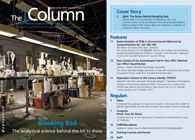Diagnosing Eye Disorders
Scientists from the Duke Medical Center (North Carolina, USA) and the Bascom Palmer Eye Institute at the University of Miami (Florida, USA) have performed liquid chromatography coupled to mass spectrometry (LC?MS) to identify a new diagnostic marker of Retinitis pigmentosa (RP) in patient urine samples.1 RP is a disease of the eye that causes retina degradation and can result in blindness. Often inherited, it has multiple contributing genetic mutations and there is no treatment available.
Scientists from the Duke Medical Center (North Carolina, USA) and the Bascom Palmer Eye Institute at the University of Miami (Florida, USA) have performed liquid chromatography coupled to mass spectrometry (LC–MS) to identify a new diagnostic marker of Retinitis pigmentosa (RP) in patient urine samples.1 RP is a disease of the eye that causes retina degradation and can result in blindness. Often inherited, it has multiple contributing genetic mutations and there is no treatment available.
Ziqiang Guan of Duke Medical University told The Column that his collaborators Rong Wen and Dr Byron Lam at the Bascom Palmer Eye Institute in Miami first discovered that a mutation in the dehydrodolichol diphosphate synthase (DHDDS) gene was responsible for a subtype of RP in 2011. Guan said: “Later, it was found that DHDDS mutations are far more common in individuals of Ashkenazi Jewish heritage than in the general population. My collaborators initially sought my expertise in mass spectrometry (MS) and dolichol analysis to assess the effects of this DHDDS gene mutation on the biosynthesis of dolichol, a lipid with many biological and physiological roles.“
The team began by analyzing cultured cells, fibroblasts, taken from a family in which three out of four children were diagnosed in their teenage years. Reversed-phase LC coupled with multiple-reaction monitoring mode (MRM) was later performed on a triple quadruple mass spectrometer to analyze plasma, and subsequently urine samples. The method was reported by Guan to be very sensitive and require less than 1 mL of urine or blood sample. Furthermore, the ratio meaurement of dolichol-18 and dolichol-19 (D18/D19) for this diagnostic test is a major advantage according to Guan, because it removes the effects of fluctutations in diachols caused by possible changes in diet, fluid intake, and time of collection.
In three siblings diagnosed with RP, dolichol profiles were shorter than in an unaffected sibling from the same family. Dolichol-18 was identified to be at higher or dominating levels in the urine of the affected siblings while dolichol-19 was dominant in the unaffected sibling. When asked to comment on the results, Guan told The Column: ”We were pleasantly surprised that the urinary and plasma dolichol profiles of RP patients could be easily distinguished from those of the carriers, which in turn are different from those of normal individuals. These observations have been verified in a total of nine patients and 35 carriers for whom we have performed dolichol profiling so far.”
The new screening method provides yet another example of how chromatography is making its way into clinical diagnosis. The potential of screening urine and plasma samples for diagnosing genetic disease is a major advantage over existing methods. According to Guan, dolichol profiling is better than gentotyping (analyzing DNA) because it can directly correlate phenotype (disease symptoms) with alterations in metabolism. He said: ”Dolichol profiling can serve as a guide for the future development of therapeutics for RP caused by DHDDS mutations.”- B.D.
Reference
R. Wen, B.L. Lam, and Z. Guan, Journal of Lipid Research DOI: 10.1194/jlr.M043232 (2013).
This story originally appeared in The Column. Click here to view that issue.

A Novel LC–QTOF-MS DIA Method for Pesticide Quantification and Screening in Agricultural Waters
May 8th 2025Scientists from the University of Santiago de Compostela developed a liquid chromatography quadrupole time-of-flight mass spectrometry (LC–QTOF-MS) operated in data-independent acquisition (DIA) mode for pesticide quantification in agriculturally impacted waters.
Investigating 3D-Printable Stationary Phases in Liquid Chromatography
May 7th 20253D printing technology has potential in chromatography, but a major challenge is developing materials with both high porosity and robust mechanical properties. Recently, scientists compared the separation performances of eight different 3D printable stationary phases.

.png&w=3840&q=75)

.png&w=3840&q=75)



.png&w=3840&q=75)



.png&w=3840&q=75)









